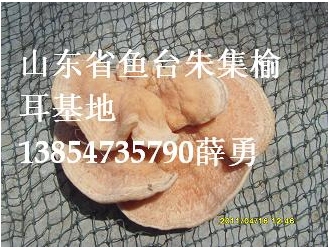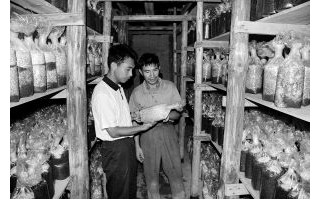RAPD/BSA Analysis on Monokaryotic Strains of Different Mating Types of Auricularia auricula
Abstract:Monokaryotic strains H2 and J3 were respectively developed from the cultivated strains He-1 and Ju-1 of Auricularia auricula through protoplasted monokaryon technique. Dikaryotic strain H2J3 was bred through crossbreeding of H2 and J3 as parents. Fifty-two monokaryotic F1 strains were obtained from the fruitingbodies of dikaryon H2J3 of A. auricula by the single-spore isolation.Auricularia auricula is of the single-factor controlled mating system according to mating test among the F1 progenies and their parents, combining the method of dyeing the nuclei of the mycelia and observing the nuclear phase under the fluorescence microscope and the method of observing the clamp connection under the light microscope to determine whether the dikaryotic mycelia were formed. Based on the mating type phenotype, the F1 progenies were divided into two groups, and two isogenic pools were constructed by mixing equally DNA of the strains of each group. Of 64 random primers, primer S 126 amplified a specific band S1261021 between the two pools, and the amplification result of the progenies and their parents which are of the same mating type suggested that S1261021 is the molecular marker linked to the mating type gene.
Keywords:Auricularia auricula; mating type; haploid strain; RAPD/BSA; molecular marker
黑木耳不同交配型的单倍体菌株RAPD/BSA分析
伍昌胜 黄亚东 边银丙
摘 要:从黑木耳(Auricularia auricula)种内杂交子H2J3的子实体上单孢分离培养得到F1代52个单核体菌株,将F1子代及亲本(H2,J3)等所有供试单核体菌株的菌丝体两两配对培养,采用核荧光染色观察核相,和光学显微镜观察锁状联合,鉴别菌丝交配反应是否形成双核体菌丝,同时测定了亲本菌株所有F1子代的交配型.根据交配型表型将F1子代菌株分成两群(F1-A1,F1-A2),将每群内各自菌株的DNA等量混合,构建交配型基因的等基因池,通过64个随机引物的RAPD分析,发现引物S126在2个等基因池间扩增出差异带S1261021,且在属于同一交配型的亲本及F1子代之间扩增结果基本一致,表明S1261021是与交配型基因连锁的分子标记.
关键词:黑木耳; 交配型; 单倍体菌株; RAPD/BSA; 分子标记
CLC Number:S646.6
Foundation Item:Supported by National Natural Science Foundation (30270931)
Author Resume:Wu Changsheng, male, born in 1976, Ph.D student of Institute of Microbiology, Chinese Academy of Sciences, Beijing 100081.边银丙,Corresponding author, bybbybbyb1@vip.sina.com
Author Unit:伍昌胜(华中农业大学应用真菌研究所,武汉,430070)
黄亚东(华中农业大学应用真菌研究所,武汉,430070)
边银丙(华中农业大学应用真菌研究所,武汉,430070)
References:
[1]Liu Z T, Luo X C. The biotechnology and application of mushrooms. Beijing:Tsing Hua university Press, 2002. 20~51
[2]Michelmor R W, Paran I, Kesseli R W. Identification of markers linked to disease resistance genes by bulked segregant analysis. Pro Natl Acad Sci USA, 1991, 88:9828~9832
[3]Wu K Y, Bian Y B. Identificating technique of intraspecific hybrids in Auricularia auricula. Mycosystema,2002, 21(2):202~224
[4]Luo X C.The studies on sexuality of Auricularia auricula and Auricularia polytrica.Acta mycological sinica,1988,7(1): 56~61
[5]Kothe E. Mating type genes for basdiomycetes strain improvement in mushroom farming. Microbiol Biotechnol, 2001, 56(Appl): 602~610
[6]Raper J R. Genetics of sexuality in higher fungi. New York:academic press, 1966
[7]Weng Y J, Chen D M. Molecular markers and its clone for salt tolerance gene in wheat. Acta Genetica Sinica, 2002, 29(4):343~349







